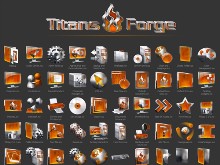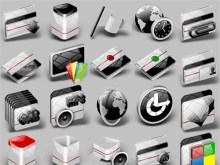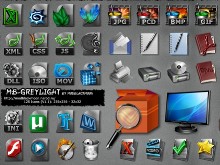Promoting Yourself and Your Skins
Tuesday, August 16, 2011 by Island Dog | Discussion: Personal Computing
People often ask me how to get more views and downloads for their skins. We get a real decent amount of traffic on WinCustomize, but sometimes standing out from the rest of the pack is difficult. We try to feature and promote people as much as we can, but there just so much that can be done by just one or two people here. If you check out our WC Facebook page, we often post skins and news there which has introduced WinCustomize to a whole new group of people.
I wanted to share some various tips that can you and your skins get more attention, which in turns helps WinCustomize as well. It’s a win-win!
Make a Tumblr blog. (www.tumblr.com)
These are quick blogs that people often use for photography and displaying images of all sorts. I actually have one setup for desktop customization, but unfortunately I lack the time to post skins there on a regular basis. Open your own blog, or even volunteer to help with this one.
Use e-mail signatures.
Whether you use a web e-mail service like Gmail or Hotmail, or a client like Outlook or Thunderbird, most have a way to create and save signatures that can be used on your outgoing mail. Depending on what they allow, these are usually rich text or html-based signatures. As you can see from my work one below, I have a link going to the Stardock.com page, and links to our various social networks. E-mail is very common obviously, so placing a link to your galleries or profile is another way to spread the word about yourself.
Share Yourself!
Use social networks to your advantage. Share your individual skins on whatever networks you have access to. Many of these have tools like browser bookmarklets that make sharing pretty easy.
Best places to share:
- www.twitter.com
- www.facebook.com
- www.stumbleupon.com
- http://www.delicious.com/
- http://plus.google.com
Let me make a reminder you don’t have to do any of this. These tips are for people who are looking to expand their reach and willing to do a bit of work to achieve that.
Customizing Stardock Fences
Thursday, July 28, 2011 by Island Dog | Discussion: Personal Computing
People send us messages every day via Twitter and Facebook telling us how much they love using Fences to organize their desktop. One thing I have noticed when talking with people is some don’t realize how you can customize Fences with a variety of options available.
If you don’t already have Fences, grab the free download here: https://www.stardock.com/products/fences/
I would suggest upgrading to the Pro version as it has some valuable options like automatic sorting, fading effects, and more.
Customizing the Labels of Fences
As I said, Fences has a variety of options to tweak the look of the actual Fences on your desktop. When I find a new wallpaper or WindowBlinds skin I like, I will adjust my Fences to fit in with the overall look I am trying to achieve. Clicking the appearance button in the Fences configuration is where we will start.
The first way to customize Fences is choosing the layout of labels. The label is the name displayed on your Fence, and the screenshot below shows my Links fence. In the Fences configuration you can choose not to display the label, have it always displayed, or only display on mouseover.
Adjusting Transparency
Adjusting the transparency of Fences is probably what I do most option. I do this to make the Fences either more or less visible on the desktop, depending on what wallpaper I am using at the time. Adjust this is really simple, just move the slider left or right to adjust the amount of transparency given.
Coloring
If you want to really change the look of the Fence, you can use the color, tint, and saturation sliders to adjust the coloring of Fences.
Misc. Tweaks
There’s a few more options available in the Appearance section to tweak Fences even further.
- Change label text color
- Outline the Fence area
- Fade scrollbars when inactive
- Hide shortcut arrows on icons
A feature available in the Pro version of Fences is having Fences being faded until mouseover. Right-click on a Fence, select View, then Opacity. Select the transparency percentage you want, and then your Fence will be faded until mouseover.
I hope this helps you customize Fences a bit more, and be sure to show us how you are using Fences on your desktop!
Microsoft Opening More Retail Store Locations
Wednesday, July 13, 2011 by Island Dog | Discussion: Personal Computing
Microsoft is expanding their network of retail stores in the coming years. There’s only a handful of them now, but over the next 3 years they are going to expand to at least 75 new stores around the country.
Via Neowin:
Plymouth Patch Article about Stardock
Tuesday, July 12, 2011 by Island Dog | Discussion: Personal Computing
Here's a great article about Stardock from a local website.
In lieu of a front-desk receptionist is a young, bearded man in a purple t-shirt, cut-off shorts and flip-flops. This is Matt Bertsch, a technical adviser for the independent software company. On his desk sits a variety of emptied craft-beer bottles, statuettes, a variety of props and an opened deck of playing cards.
Bertsch explains that the usual receptionist just moved to Dallas for other Stardock-related duties as he retrieves Brad Wardell, the president and CEO of Stardock, who occupies a top-floor office with his dog.
Favorite Design Blogs and Websites
Wednesday, June 29, 2011 by Island Dog | Discussion: Personal Computing
I use Google Reader to browse through a variety of websites many of which are design related. It’s a great way to get some inspiration and tips. Some of these sites also have lots of free downloads like Photoshop brushes and patterns.
Here are some of my favorites:
Got any to share?
Cursor FX Resources
Wednesday, June 22, 2011 by Island Dog | Discussion: Personal Computing
We have a Summer CursorFX contest going on, and I wanted to post some helpful resources for people getting started with both using and creating CursorFX themes.
Contest details: https://forums.wincustomize.com/409745
Getting CursorFX
CursorFX has both a free and Plus version available. The Plus version adds features such as effects, cursor trails, cursor resizing, coloring, and much more. More information and downloads can be found at the CFX website - https://www.stardock.com/products/cursorfx/.
Creating Custom Cursors
Both versions of CursorFX include a cursor editor which lets you easily create new cursor themes. You will need to create your graphics in another application, but the CFX Editor will allow you to put those images together into a cursor theme.
The WinCustomize Wiki has a bunch of resources for CursorFX and many other skinning programs.
Additional Resources
How to Customize Windows 7-The Definitive Guide
Skins, Themes, Wallpapers, Cursor, and more!
Friday, June 10, 2011 by Island Dog | Discussion: Personal Computing
Windows 7 has become very popular, and it is the top operating system that people use when visiting WinCustomize. With eyes already on Windows 8 I wanted to create the “definitive” guide to skinning Windows 7 based on skins, themes, and the best associated software you can find on WinCustomize.com. The items I list below will be a mixture of freeware and paid software, and links to downloads and product pages will be included.
There are also plenty of resources to show you how to use these apps in more detail. One of the best is the WinCustomize Wiki where there are tutorials and documents for all the applications mentioned here, plus many more.
If you would like to see more video demos, please visit our YouTube page.
Customizing the Boot Screen
With changes made in Windows 7 is not as easy to change the Boot screen as it was in say Windows XP. There are some free tools out there that can change the boot screen, but the risk of your system not booting can be quite how so I do not recommend changing this. Having to repair or reinstall your operating system is not worth the boot screen changing.
Changing the Win7 Logon Screen
Now we get to something much easier to skin, and best of all the tool to do it is free! LogonStudio is an application that lets you change your Windows 7 logon screen with just a few clicks. You can use your own images simply by dragging and dropping them into the LogonStudio window, or you can download logon skins from WinCustomize.
LogonStudio (free)
Applying Cool Cursor Themes
Having a customized cursor theme is one of my personal favorites as there are so many creative cursor themes out there to use. Again, this is quick and easy to customize and the results are fantastic. Everyone will want to know where you got those cool custom cursors from. For this we are using CursorFX which has both a free and paid version. CursorFX Plus gives you several advantages and advanced features such as effects on mouse clicks, trails, cursor resizing, and more.
There are literally thousands of custom cursors available for download, and CursorFX also includes an editor for making your own cursors.
CursorFX (free and Plus version)
Change the Complete Desktop Theme
So far we have done a few things to change the Windows experience, but next up we are going to change just about everything of the Windows user interface. Over the years this has been done by hacking resource files in Windows, or using a 3rd party app like WindowBlinds. Hacking resources was used because it was “free”, but technically limited on to what could be skinned, and of course hacking system files can lead to system instability and problems. Now at version 7, WindowBlinds has continually been updated to support the latest Windows operating systems and to include features to enhance the look of Windows.
WindowBlinds is the recommend choice as it does not hack system files, uses virtually no resources, and is developed by a Microsoft Gold Partner. Aside from that, it has some phenomenal features like adjustable transparency, wallpaper management, textures, Aero skinning, and much more. Check out this demo video to see it in action.
WindowBlinds ($19.95)
Animated Wallpapers
With the introduction of Windows Vista, we were able to see the first effective use of animated wallpapers on the Windows desktop. DreamScene didn’t last long though as it was removed with Windows 7, but during that time Stardock had released DeskScapes which took animated wallpapers to another level. DeskScapes not only brought animated wallpapers to all versions of Windows (XP and up), it also introduced dynamic wallpapers, multi-monitor support, wallpaper effects, and many more features. The .dream format was also made available so designers could easily take video footage or 3D renders, and quickly make them available to use and share.
Changing Desktop Icons
Icons in Windows are another things that you interact with quite often. There’s really nothing more plain than the default icons in Windows, but as with mostly everything else, they are also easily changed with just a few clicks. IconPackager has been around for years and is really the only solution to change your entire set of Windows icons at once. Instead of changing icons one by one, IconPackager uses an entire package of icons to change nearly all the icons at the click of a button. Of course you can change icons individually, but there are thousands of icon packs available that can apply a matching set across your entire Windows PC.
IconPackager ($19.95, free trial)
Desktop Organization
Make your desktop look good is one thing, but making it productive is another production in itself. Two items that are mostly found on all desktops are going to be the icons and active or inactive windows on your screen. We have all seen people who have literally hundreds of icons spread out over their desktop, and I know you cannot easily find something wading through that mess. There are two really good applications that can help you organize and manage your desktop icons, Fences and ObjectDock.
ObjectDock
ObjectDock puts a “dock” on your desktop that can either be a normal zoomer-type dock, a tabbed dock, or a mix of both with the Plus version. I use ObjectDock to keep application icons in an organized set of tabs that I can quickly access.
As you can see in the screenshot above, I have tab categories for Office applications, game shortcuts, etc. When I need to launch an application I don’t have to search through the start menu – I can easily open it by going to ObjectDock.
ObjectDock (free and Plus versions)
Fences
Next we have Fences which is designed to organize your desktop icons to help reduce clutter and allow you to sort icons for quick access. You can create “fences” that can be labeled to place your icons into which then can be moved around and placed on your desktop however you like. You can adjust the size and shape of the fences to fit your needs, and the Pro version adds the ability to add advanced sorting features, fading Fences, and icon sorting rules.
Fences (free and Pro version)
Other Great Desktop Applications
What we talked above are some of the best applications for changing the look of Windows. There are so many other apps that do cool things and compliment the other applications well to give you a complete desktop transformation.
Sysmetrix – This is a fantastic application that puts all kinds of meters, weather info, clocks, and so much more on your desktop. It’s a favorite among skinners and there are some truly awesome theme designs for it.
Rainmeter – Another desktop favorite is Rainmeter. This also put all types of mini-applications on your desktop and has a great community behind it making some beautiful themes and applets.
Rainlender – Need a calendar on your desktop? Look no further as this is one of the best there is. This is a customizable calendar app that puts events and tasks right in front of you.
Winstep – Winstep has several different applications that can really transform your entire desktop into something sweet. There’s a lot to checkout about Winstep, so visit their site for all the info! You can also find Winstep themes at WinCustomize.
Use Tiles for a Minimal Desktop Setup
Tuesday, May 10, 2011 by Island Dog | Discussion: Personal Computing
Tiles is the newest app in the Object Desktop lineup, and it’s main purpose is to manage running applications and windows on your desktop. It is also useful to those who want to achieve a minimalistic desktop environment, and today I will show you how I did that using Tiles.
Right-clicking inside Tiles gives you a menu of various options, and here is where we will start. Right-click and select Size and location, then select Hide taskbar. As it says, this will hide your Windows taskbar clearing up a big part of your desktop.
Really at this point, you are there already with a minimal desktop. All you should have now is your wallpaper and Tiles, and since I use the smallest size of Tiles it is tucked away nicely on the right side of my screen. I have a Tiles page setup that hold my frequently used shortcuts, and I set the date, time, and running tasks to be shown so I have just about everything I need in Tiles.
Of course if you want to go the extra step, you can also auto hide Tiles and have just a tab showing to make it active. That’s a little too minimal for my taste, but the options are there!
More about Tiles here.
IconPackager Changes those Bland Desktop Icons
Thursday, April 7, 2011 by Island Dog | Discussion: Personal Computing
One aspect of the Windows desktop customization experience that is often overlooked is the icons. These are things you interact with so often I think even I sometimes just glance over them. As with many things in the default Windows desktop, the icons are bland and are the same from desktop to desktop. All these icons can easily be changed by using a tool from Stardock called IconPackager. IconPackager has been around for years, and has well over 4 million downloads on Download.com alone.
Open IconPackager, browse through the installed icon themes, hit apply and you have a completely new icon set for your PC! Icons can be changed individually or all at once using packs of icons. Thousands are available for download on WinCustomize.com with an almost endless variety of styles to choose from.
Head over to the IconPackager website to download the free trial version! IconPackager is also part of the Object Desktop suite with many other desktop customization and utility apps.
https://www.stardock.com/products/iconpackager/
Popular Icon Packs for IconPackager
How Have You Been Using Stardock Tiles?
Tuesday, March 22, 2011 by Island Dog | Discussion: Personal Computing
Tiles from Stardock has been out (in beta) to Object Desktop subscribers for a couple of weeks, and I wanted to follow up and ask our users how they like it so far, and how you have been using it. For me, it’s quite common that I have many windows open, and I have used Tiles to fast switch to each window without having to look at the task bar.
I also use a custom page to drag certain document windows to keep them in a place I can quickly access them.
https://www.stardock.com/products/tiles/
How have you been using it?









































































